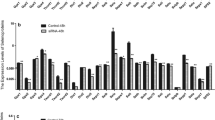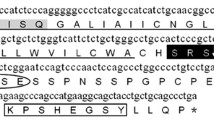Abstract
Selenoprotein S (SelS), a member of selenoprotein family, plays important regulatory function in inflammation and metabolic diseases. SelS expression is up-regulated response to the inflammatory stimulus in many mammal cells, animal models as well as patients. In order to further understand the function of SelS gene, molecular characterization and transcriptional regulation of SelS from a Bama mini-pig were analyzed in the present study. The results showed that pig SelS encoded a protein of 190 amino acid with estimated molecular weight of 21.23 kDa and pI of 9.526. The genomic structure, promoter and deduced amino acid sequence were analyzed and found to share high similarity with those of human SelS. Pig SelS fusion protein was demonstrated to localize in the cytoplasm by fluorescence microscopy. Real-time PCR revealed the ubiquitous expression pattern of pig SelS in diverse tissues, a high level expression was observed in the liver and lung, relatively low expression in other tissues, especially in muscle. Promoter deletion analysis further suggests that an NF-κB binding site within the SelS promoter is responsible for the up-regulation of SelS transcription.





Similar content being viewed by others

References
Kryukov GV, Castellano S, Novoselov SV, Lobanov AV, Zehtab O, Guigó R, Gladyshev VN (2003) Characterization of mammalian selenoproteomes. Science 300:1439–1443
Walder K, Kantham L, McMillan JS, Trevaskis J, Kerr L, De Silva A, Sunderland T, Godde N, Gao Y, Bishara N, Windmill K, Tenne-Brown J, Augert G, Zimmet PZ, Collier GR (2002) Tanis: a link between type 2 diabetes and inflammation? Diabetes 51:1859–1866
Gao Y, Feng HC, Walder K, Bolton K, Sunderland T, Bishara N, Quick M, Kantham L, Collier GR (2004) Regulation of the selenoprotein SelS by glucose deprivation and endoplasmic reticulum stress—SelS is a novel glucose-regulated protein. FEBS Lett 563:185–190
Kim KH, Gao Y, Walder K, Collier GR, Skelton J, Kissebah AH (2007) SEPS1 protects RAW264.7 cells from pharmacological ER stress agent-induced apoptosis. Biochem Biophys Res Commun 354:127–132
Kelly E, Greene CM, Carroll TP, McElvaney NG, O’Neill SJ (2009) Selenoprotein S/SEPS1 modifies endoplasmic reticulum stress in Z variant alpha1-antitrypsin deficiency. J Biol Chem 284:16891–16897
Gao Y, Walder K, Sunderland T, Kantham L, Feng HC, Quick M, Bishara N, de Silva A, Augert G, Tenne-Brown J, Collier GR (2003) Elevation in tanis expression alters glucose metabolism and insulin sensitivity in H4IIE cells. Diabetes 52:929–934
Zeng J, Du S, Zhou J, Huang K (2008) Role of SelS in lipopolysaccharide-induced inflammatory response in hepatoma HepG2 cells. Arch Biochem Biophys 478:1–6
Alanne M, Kristiansson K, Auro K, Silander K, Kuulasmaa K, Peltonen L, Salomaa V, Perola M (2007) Variation in the selenoprotein S gene locus is associated with coronary heart disease and ischemic stroke in two independent Finnish cohorts. Hum Genet 122:355–365
Bos SD, Kloppenburg M, Suchiman E, van Beelen E, Slagboom PE, Meulenbelt I (2009) The role of plasma cytokine levels, CRP and Selenoprotein S gene variation in OA. Osteoarthritis Cartilage 17:621–626
Marinou I, Walters K, Dickson MC, Binks MH, Bax DE, Wilson AG (2009) Evidence of epistasis between interleukin 1 and selenoprotein-S with susceptibility to rheumatoid arthritis. Ann Rheum Dis 68:1494–1497
Du JL, Sun CK, Lü B, Men LL, Yao JJ, An LJ, Song GR (2008) Association of SelS mRNA expression in omental adipose tissue with Homa-IR and serum amyloid A in patients with type 2 diabetes mellitus. Chin Med J 121:1165–1168
Karlsson HK, Tsuchida H, Lake S, Koistinen HA, Krook A (2004) Relationship between serum amyloid A level and Tanis/SelS mRNA expression in skeletal muscle and adipose tissue from healthy and type 2 diabetic subjects. Diabetes 53:1424–1428
Gao Y, Pagnon J, Feng HC, Konstantopolous N, Jowett JB, Walder K, Collier GR (2007) Secretion of the glucose-regulated selenoprotein SEPS1 from hepatoma cells. Biochem Biophys Res Commun 356:636–641
Windmill K, Tenne-Brown J, Bayles R, Trevaskis J, Gao Y, Walder K, Collier GR (2007) Localization and expression of selenoprotein S in the testis of Psammomys obesus. J Mol Histol 38:97–101
Seiderer J, Dambacher J, Kühnlein B, Pfennig S, Konrad A, Török HP, Haller D, Göke B, Ochsenkühn T, Lohse P, Brand S (2007) The role of the selenoprotein S (SELS) gene −105G > A promoter polymorphism in inflammatory bowel disease and regulation of SELS gene expression in intestinal inflammation. Tissue Antigens 70:238–246
Curran JE, Jowett JB, Elliott KS, Gao Y, Gluschenko K, Wang J, Abel Azim DM, Cai G, Mahaney MC, Comuzzie AG, Dyer TD, Walder KR, Zimmet P, MacCluer JW, Collier GR, Kissebah AH, Blangero J (2005) Genetic variation in selenoprotein S influences inflammatory response. Nat Genet 37:1234–1241
Moses EK, Johnson MP, Tømmerdal L, Forsmo S, Curran JE, Abraham LJ, Charlesworth JC, Brennecke SP, Blangero J, Austgulen R (2008) Genetic association of preeclampsia to the inflammatory response gene SEPS1. Am J Obstet Gynecol 198:336.e1-5
Shibata T, Arisawa T, Tahara T, Ohkubo M, Yoshioka D, Maruyama N, Fujita H, Kamiya Y, Nakamura M, Nagasaka M, Iwata M, Takahama K, Watanabe M, Hirata I (2009) Selenoprotein S (SEPS1) gene −105G > A promoter polymorphism influences the susceptibility to gastric cancer in the Japanese population. BMC Gastroenterol 9:2
Hyrenbach S, Pezzini A, del Zotto E, Giossi A, Lichy C, Kloss M, Werner I, Padovani A, Brandt T, Grond-Ginsbach C (2007) No association of the −105 promoter polymorphism of the selenoprotein S encoding gene SEPS1 with cerebrovascular disease. Eur J Neurol 14:1173–1175
Martínez A, Santiago JL, Varadé J, Márquez A, Lamas JR, Mendoza JL, de la Calle H, Díaz-Rubio M, de la Concha EG, Fernández-Gutiérrez B, Urcelay E (2008) Polymorphisms in the selenoprotein S gene: lack of association with autoimmune inflammatory diseases. BMC Genomics 9:329
Wang H, Yang S, Yang E, Zhu Z, Mu Y, Feng S, Li K (2007) NF-kappaB mediates the transcription of mouse calsarcin-1 gene, but not calsarcin-2, in C2C12 cells. BMC Mol Biol 8:19
Wang HL, Wang H, Zhu ZM, Wang CF, Zhu MJ, Mo de L, Yang SL, Li K (2006) Subcellular localization, expression patterns, SNPs and association analyses of the porcine HUMMLC2B gene. Mol Genet Genomics 276:264–272
Papp LV, Lu J, Holmgren A, Khanna KK (2007) From selenium to selenoproteins: synthesis, identity, and their role in human health. Antioxid Redox Signal 9:775–806
Bar-Noy S, Gorlatov SN, Stadtman TC (2001) Overexpression of wild type and SeCys/Cys mutant of human thioredoxin reductase in E. coli: the role of selenocysteine in the catalytic activity. Free Radic Biol Med 30:51–61
Gu QP, Beilstein MA, Barofsky E, Ream W, Whanger PD (1999) Purification, characterization, and glutathione binding to selenoprotein W from monkey muscle. Arch Biochem Biophys 361:25–33
Beilstein MA, Vendeland SC, Barofsky E, Jensen ON, Whanger PD (1996) Selenoprotein W of rat muscle binds glutathione and an unknown small molecular weight moiety. J Inorg Biochem 61:117–124
Hotamisligil GS (2010) Endoplasmic reticulum stress and the inflammatory basis of metabolic disease. Cell 140:900–917
Marciniak SJ, Ron D (2006) Endoplasmic reticulum stress signaling in disease. Physiol Rev 86:1133–1149
Wu Y, Zhou BP (2010) TNF-alpha/NF-kappaB/Snail pathway in cancer cell migration and invasion. Br J Cancer 102:639–644
Di J, Pang J, Sun Q, Zhang Y, Fang Y, Liu X, Zhou J, Ruan X, Gao X (2009) Toll-like receptor 9 agonists up-regulates the expression of cyclooxygenase-2 via activation of NF-κB in prostate cancer cells. Mol Biol Rep 37(4):1849–1855
Acknowledgments
This work was supported by The National Natural Science Foundation of China (30800779, 30628019), The Ministry of Science and Technology of China (2008AA10Z143, 2009CB941604) and The Funding of State Key Laboratory of Animal Nutrition of China.
Author information
Authors and Affiliations
Corresponding author
Electronic supplementary material
Below is the link to the electronic supplementary material.
Rights and permissions
About this article
Cite this article
Zhang, N., Jing, W., Cheng, J. et al. Molecular characterization and NF-κB-regulated transcription of selenoprotein S from the Bama mini-pig. Mol Biol Rep 38, 4281–4286 (2011). https://doi.org/10.1007/s11033-010-0551-y
Received:
Accepted:
Published:
Issue Date:
DOI: https://doi.org/10.1007/s11033-010-0551-y



